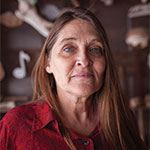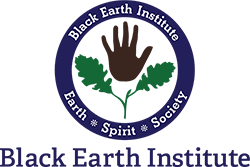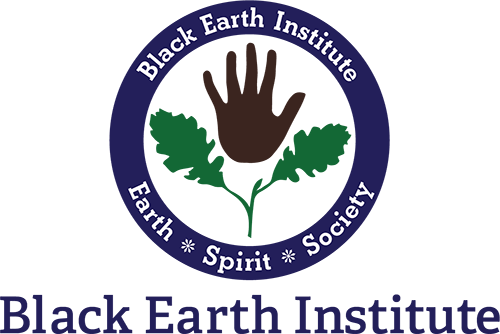
Allison Hedge Coke was Nominated for ‘Poetry/Science: Lab Coats for House Coats’ and ‘Blue Whale.’ Both pieces were published and nominated by The Scarlet Tanager.
Poetry/Science: Lab Coats for House Coats
I’ll start out with this statement: Science is a natural way of perceiving and witnessing for the purpose of knowing. It’s trial and error, experiment, and it’s given us all sorts of healing and culinary wonders, some from otherwise deadly sources. It’s brought us to understand our ways of being, to match our ways of knowing from stories that predate our existence by a stream of generations before us and our surrounding environments’ and ecosystems’ dictations and needs in reciprocity. We are symbiotic, or not. When not, we are oftentimes completely out of balance, out of kinship. Contemporary science attempts to reason with what older cultures around the world have already proven and known and have the scientific knowledge built within cultural practices and understandings—within doings. This knowing, as well, is essential to our survival on the planet, our beingness. Poets and scientists share a main line—curiosity. It inspires and activates us wholly.
I came into the world in a familial knowing of science being a part of everything. Be it a cultural science or contemporary knowledge of science.
If you asked my father a question, he might answer you over years, each incident bringing in some sense of older knowing and some sense of perception or perceiving. Math and science were integral parts of our traditional familial knowledge in our home. Raised by a storyteller and singer who was born in 1922, whose parents were born in 1878 and 1882 (the latter, his mother, a root doctor and midwife), by my father, a storyteller who married a musician who worked with him on the polio epidemic as some of the first physical therapists in the world. They continued their work in hospital until my father used his cobbled-together World War II G.I. Bill B.A. in chemistry (because he was spending time playwriting) to return to work as an analytical chemist, as he had been as a layman, at Phillips, before he met my mother. His first hire outside of field labor, or riding fence, and military service.
We wore lab coats in our home as house coats. Everything had to do with cultural kinship, and everything was, truly, related.
We interwove a traditional sense of science and modern science due to my father’s work. We could have survived alone in the elements for some time—any of us as kids—with the knowledge of survival and nature hacks we were immersed in. And on the other hand, the periodic table was not an uncommon chart in our home and seemed to us common knowledge. Science, physics, astronomy, medical terminology, physiology, chemistry, were as typical a conversation as original stories or songs.
Actually, they were an element of inclusion in all of this and in the way my father spoke of any other feature of childhood, steeped in oratory and cultured by an older generation. Science has always been, it just wasn’t a separate study, or discipline thought to be modern until more recent times.
Early on, in our home, my father taught me square roots and basic algebraic equations while he was studying refresher courses for a job. He kept telling me to do the puzzles to keep from bothering him too much. He would write problems on paper and explain what to do and have me solve them, preschool aged. We used numbers to play binary code puzzles and other games, and we were well aware that when leaves fell, they were filled with anthocyanin.
We also knew the traditional stories of the same trees.
We knew mound cities were laid out in accordance with stellar events and cycles in the heavens. We understood physics and astronomy as a way to speak about everyday occurrences like friction or meteor showers we camped underneath. And the stories that went along with those occurrences as well. The flow of water, of air, the thermals birds soar, migrate and sail as murmurations, when we went to bird councils, hawk councils with my father.
Just as poetry is life, science is. It depends what science you’re relating to. What is from a deeper cultural knowing that’s existed for tens of thousands of generations, or from contemporary learning and accumulation of explanations and knowing, from perceiving from outside one’s own culture. Like story and culture, they’re inextricable.
Another typical instance of reflection for us is time-skipping, in the family, or portal opening, of knowing or perceiving. This is how portend, or premonition, was explained to us, as a ripple occurring, so that if somebody is doing something that’s significant in this day and time, the generations that walk with us in our DNA, in our genetic code, feel that in the past and have premonitions of what’s happening today. And so, we’re relating to the future generations before us.
This was taught to us as children.
Just yesterday, monarch-seekers went where they normally might be immersed within nearly 50,000 monarchs in this season and only saw one or two. My works all deal with change, the planet, its peoples in different forms and the effect that man has had on the devastation of our planet and its many original cultures and beings. My forthcoming book, Look at This Blue (2022), is a one-hundred-page poem immersed in my love for the natural world and the catastrophic loss we are existing within. It’s an indictment and a love poem for my home base, California.
It’s what we do as poets. We translate the world through our curiosity and through things learned. Much like the life of a scientist.
My first poetry professor was Arthur Sze, and he came from science as well. His parents fully expected him to stay in the sciences they worked in, and at work studying at MIT. And from his time as a student there, he began also studying poetry with Josephine Miles and Denise Levertov and abandoned MIT for UC Berkeley to study poetry.
I related to him in his work immediately. (This is when I was an undergrad at the Institute of American Indian Arts many years ago.) I want to share a poem of his that demonstrates, much as I was saying, that poetry is a part of life. It’s how we live and translate the world and sciences, unimmersed or immersed within all of this.
This is “Net Light” by Arthur Sze, and I wish you could hear him read this. He gives just stunning readings. If you don’t know his work, please look him up and listen to some of his readings.
Poised on a bridge, streetlights
on either shore, a man puts
a saxophone to his lips, coins
in an upturned cap, and a carousel
in a piazza begins to turn:
where are the gates to paradise?
A woman leans over an outstretched
paper cup—leather workers sew
under lamps: a belt, wallet, purse—
leather dyed maroon, beige, black—
workers from Seoul, Lagos, Singapore—
a fresco on a church wall depicts
the death of a saint: a friar raises
both hands in the air—on an airplane,
a clot forms in a woman’s leg
and starts to travel toward her heart—
a string of notes riffles the water;
and, as the clot lodges, at a market
near lapping waves, men unload
sardines in a burst of argentine light.
So throughout the poem, we have this kinship value and the physics and physiology of people on the planet. And what’s happening within the body and its effect on everything around it including the notes in the air and the clot in the leg. Quite beautiful work that he does consistently.
And while I was in graduate school, I had the great advantage of having Alison Hawthorne Deming come in as a visiting poet. She had won the Whitman prize. We were quite impressed with her work then and I remain so today. She had spent some time with eagles and like us, being raised going to bird councils. I was all over it.
Here is a poem of Alison’s from The Monarchs:
22.
Redwoods. At night they take
the headlights without blinking,
their thousand-year-old patience
disturbed only slightly by lightning
or wildfire. To them the sorrow
of the celibate fathers is the same
as the sorrow of the missionized tribes.
They are satisfied to drink what rain
can be wrung in the billowing fog.
They tolerate nattering creatures
inhabiting their bark and branches.
Their hearts rise straight through their bodies
and are not harmed by hardening.
Unable to hear, see, smell, or taste,
they know when to drop their lower branches,
broaden their root anchor, when to
climb and bud. The redwoods, without
liquid hydrogen or God, have mastered time,
with their tracheids and sieve tubes,
their angel cells catch and release the light.
And I’ll end with a closing poem from one of my books. They’re all climate change to a degree. They all deal with physics to a degree. They all deal with the built world and the natural world. And one book, Off-Season City Pipe, is a labor collection that begins and ends with eclipses. This is “Waiting for the Last Lunar Eclipse, 2004”:
I dreamed of a sudden eclipse
revealing unexpected stars
causing me to shift in my sleep,
remember mounds assembled,
basketful by basketful—the building.
Various earths carefully compiled
commemorating dead immortal
underneath compelling skies.
A woman peeling slivers
from a great ball
hanging loose leavings
like locust leaf-silver.
Then stars filled sky—radiant.
While earth wrapped moon in rose
I imagined night briefly breaking
light barriers like pulses, in other
daytimes, somewhere far beyond.
Here in the muck of morning,
where gray slates sky
and drizzle threatens,
Oneonta, New York.
a star, or two, may hover blind.
Constantly preparing plenty
wholly pondering day,
hoping to light the world like us,
and we in welcome wait.
Blue Whale
– from Look at This Blue –
Blue Whale alongside Monterrey, San Diego, Baja
gentle giant heaviest animal to ever live on earth, twice Argentinosaurus
ship strikes kill eleven per year, US West coast, with ship increase
population will be depleted, noise, military testing, sonic battery,
chemicals, plastics – blue with belly full of plastics –
krill, anchovie, tiny fish, tiny crustaceans absorb micro-plastics
a blue whale eats between 2 and 4 tons of krill per day

